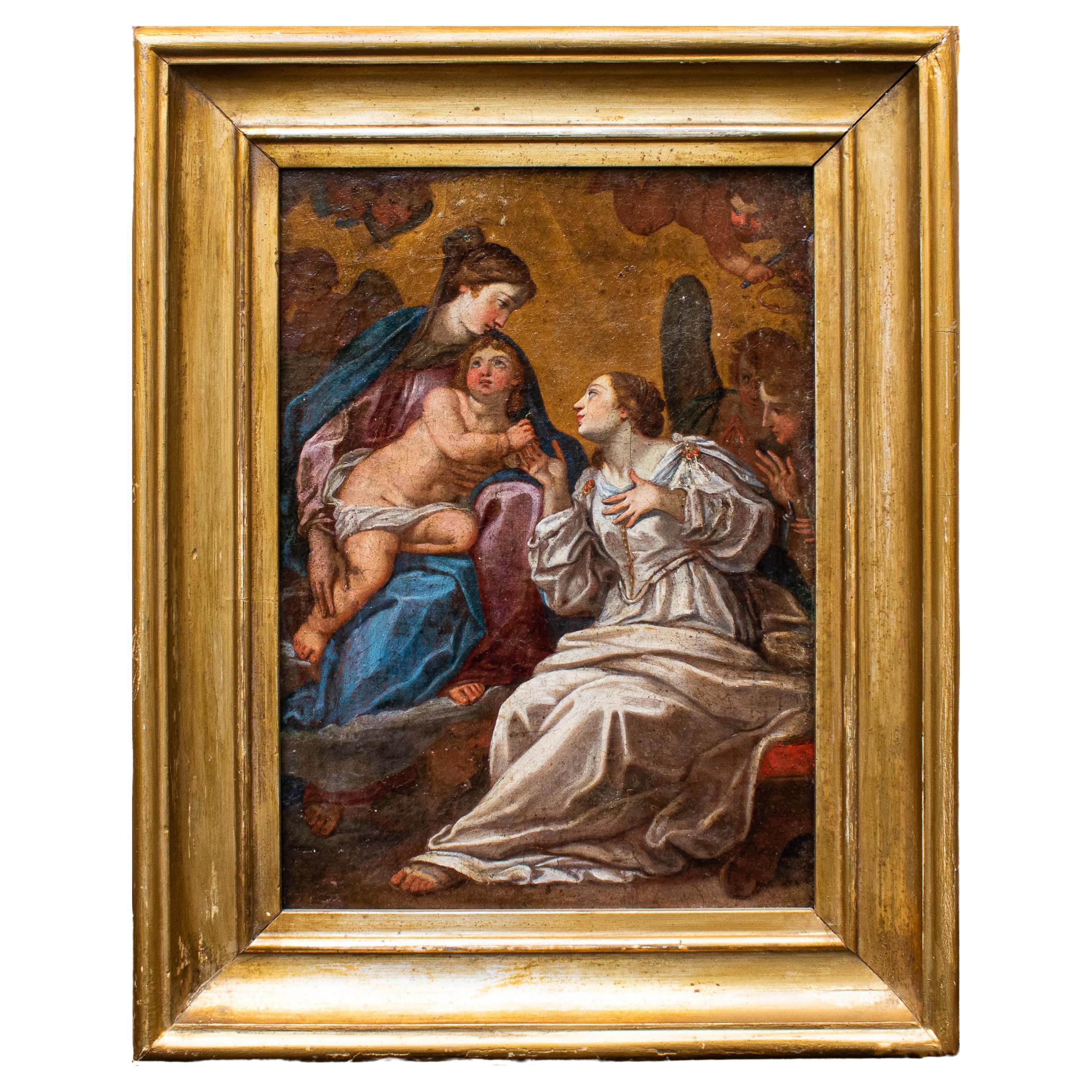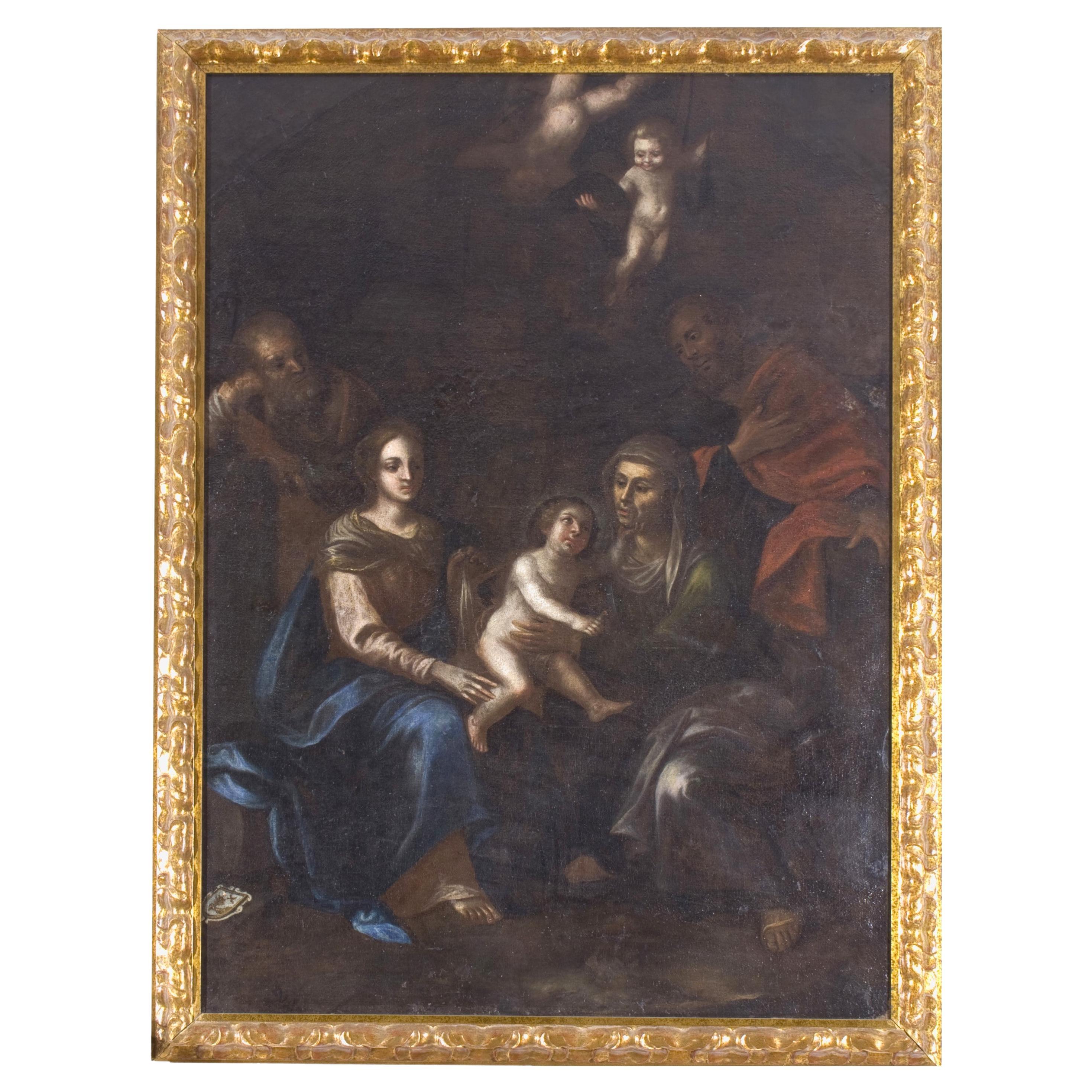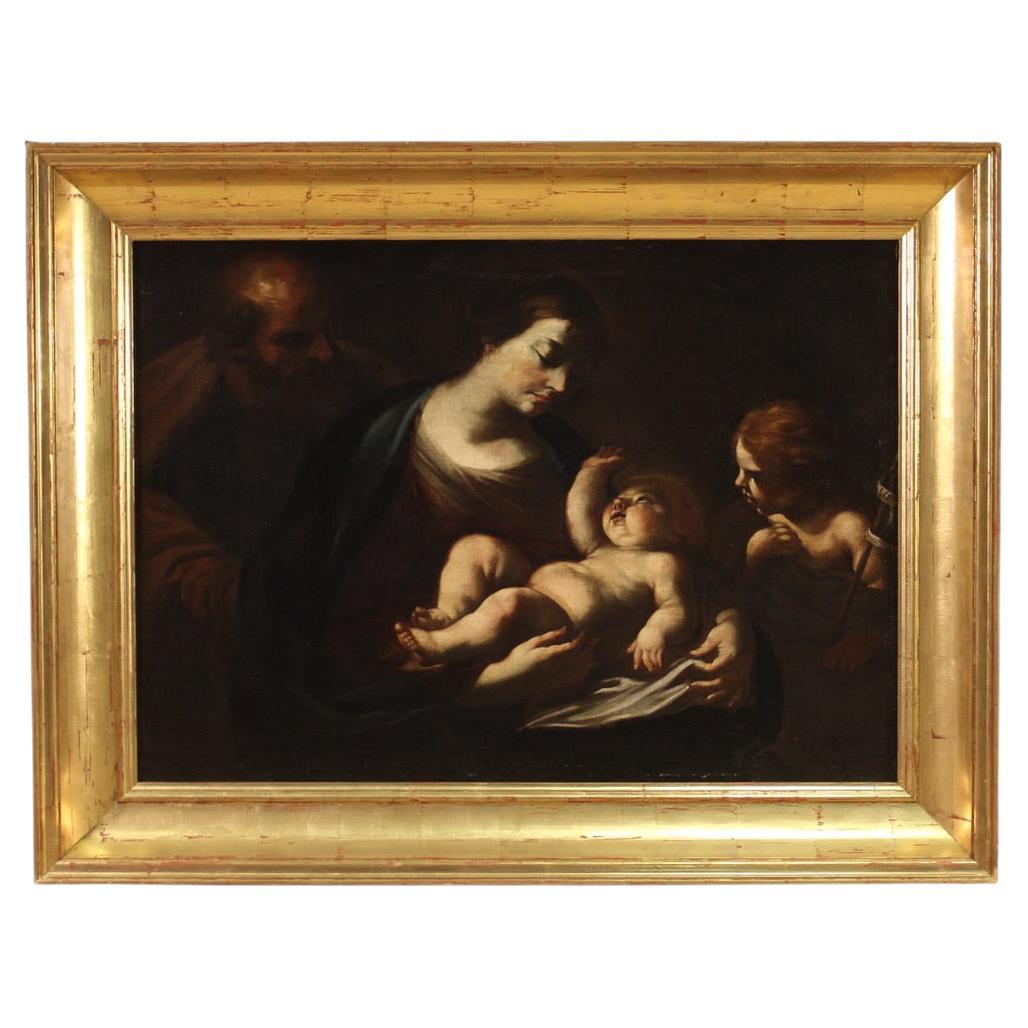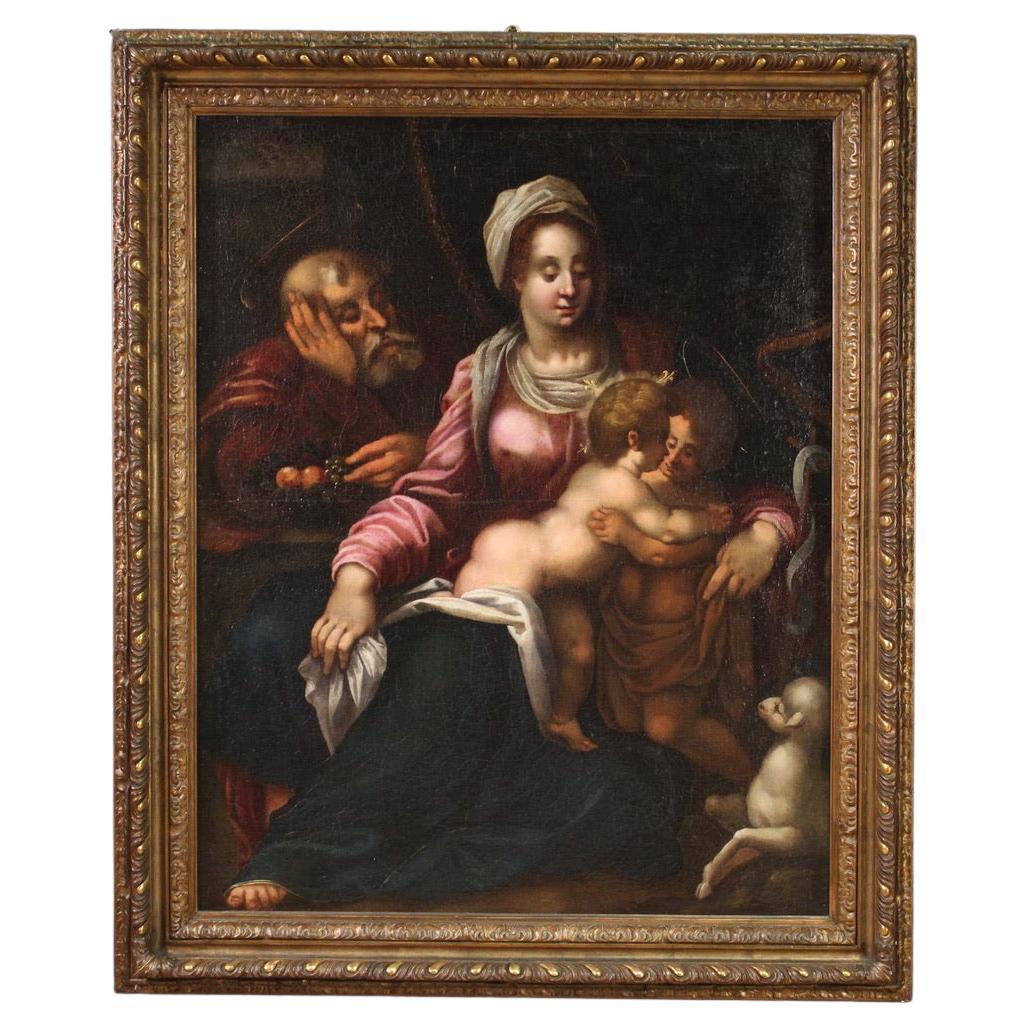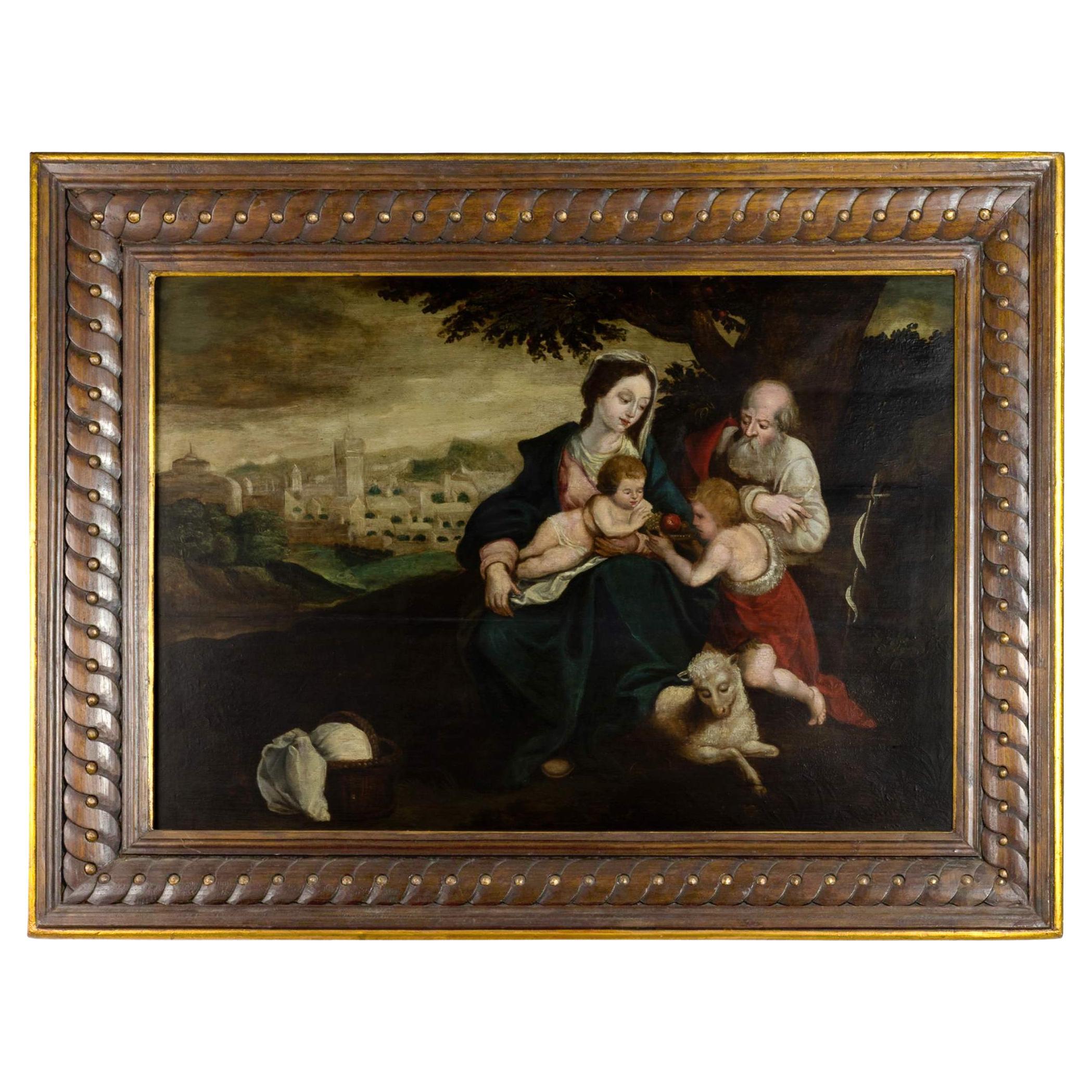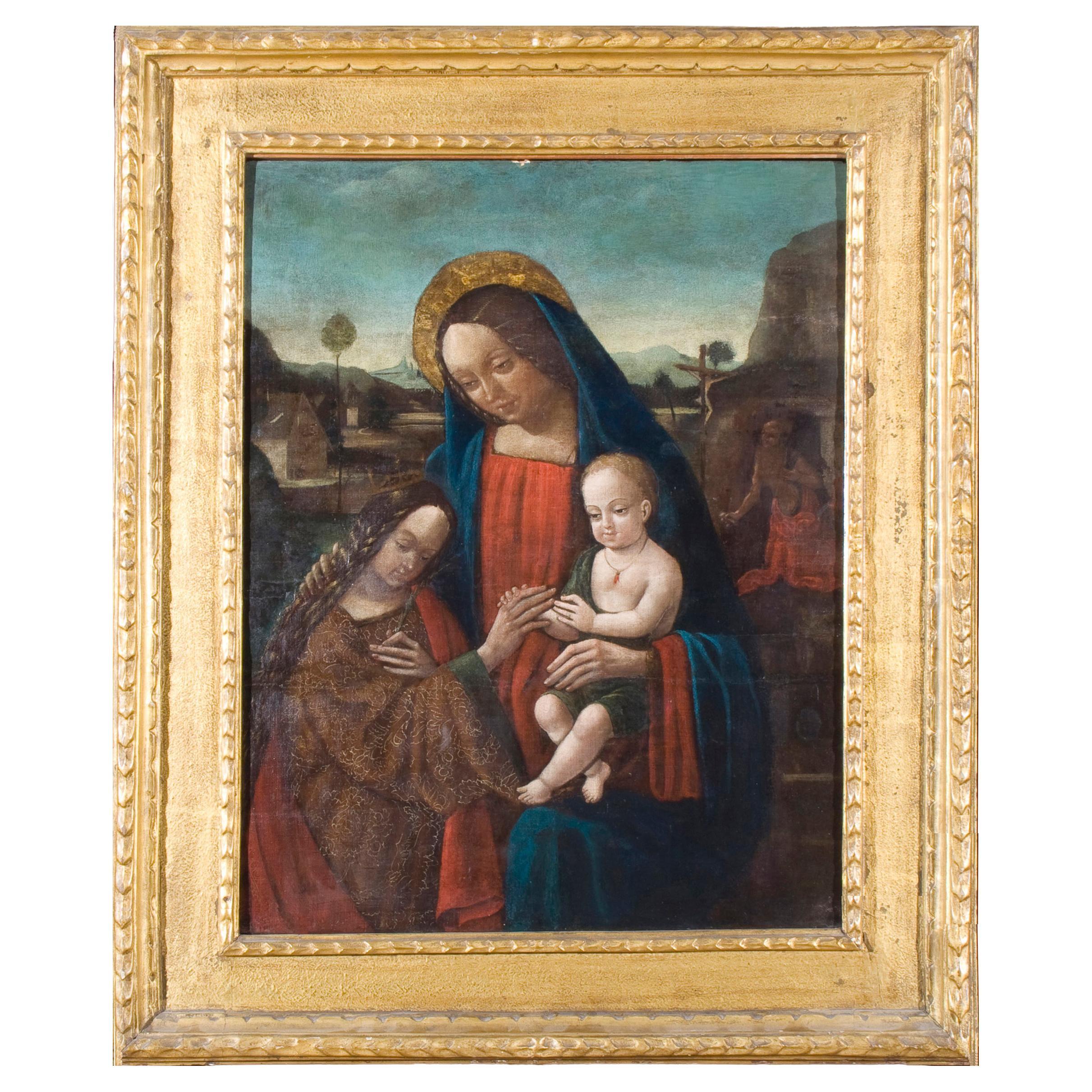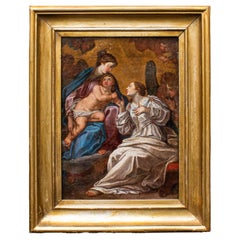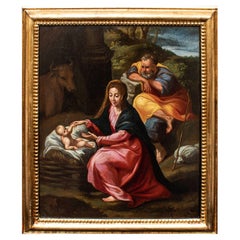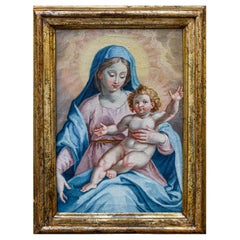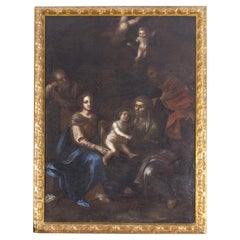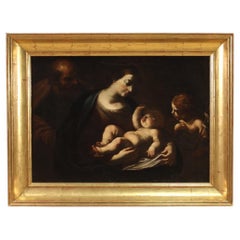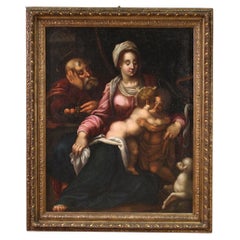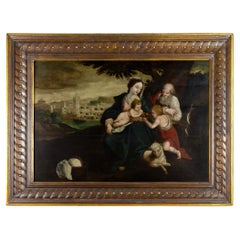Items Similar to 17th Century Mystical Marriage of Saint Catherine Painting Oil on Canvas
Want more images or videos?
Request additional images or videos from the seller
1 of 17
17th Century Mystical Marriage of Saint Catherine Painting Oil on Canvas
$5,434.68
£4,073.63
€4,600
CA$7,466.33
A$8,335.45
CHF 4,367.65
MX$102,034.14
NOK 55,469.23
SEK 52,300.44
DKK 35,016.88
Shipping
Retrieving quote...The 1stDibs Promise:
Authenticity Guarantee,
Money-Back Guarantee,
24-Hour Cancellation
About the Item
17th century
Mystical marriage of Saint Catherine
Measures: Oil on canvas, 98 x 81 cm - with frame 119 x 102 cm
The scene represents the mystical marriage between Catherine of Alexandria and Christ, an iconography that was born in the fifteenth century and in many cases preferred over the more bloody martyrdom of the saint with the wheel. The saint is depicted in front of the Virgin holding the Child portrayed with the wedding ring in her hand, enriched with a precious stone. According to the Golden Legend, Catherine of Alexandria was a very beautiful young woman, the only daughter of the king of Costa, who had refused to marry the emperor Maxentius because she was Christian and devoted to Christ. Maxentius, failing to convince her to sacrifice to her idols, had sent for men who were wiser than her and fifty of her among philosophers and orators who presented themselves and tried to distract her from faith in Christ. Catherine, however, fought so well that she was able to convert them, arousing the anger of the emperor who condemned them to the stake. Catherine instead, who had criticized Maxentius for the new persecutions against Christians, was sentenced to prison without food. She abandoned for twelve days, she was fed by a dove sent by God. Maxentius then decided to execute her with the torture of her toothed wheel which became her iconographic attribute of her; but by divine intervention it broke and the young woman was saved. Finally, she was beheaded and milk gushed from her neck. Catherine's princely status is here testified by her sumptuous dress. The iconography of mystical marriage was born in the fifteenth century, probably because the traditional iconographic attribute, the wheel, was sometimes so small as to look like a ring, and refers to a vision that will always remain present in the mind and heart of the saint. In her Heaven, in the midst of the Angels and Saints, Christ Child appeared to her in the arms of the Virgin. He took a precious ring that the Virgin Mary handed her and slipped it into her finger, telling her “I, your Creator and Savior, take you in marriage; confident that you will keep yourself pure as long as you celebrate your eternal wedding with me, in Paradise ”. When she awoke she Catherine she found in her finger the same ring that she had seen and had in Heaven, and she considered herself the bride of Christ forever.
The painter places at the center of the observer's attention the exchange of the ring between Christ child and the saint, arranged in the foreground inside a room, in which the entire composition is dynamically constructed. A child Saint John draws the attention of the Virgin who turns her face away, intimately leaving the silent dialogue between Saint Catherine and Christ. A more sober character is attributed to the painting, due to a more austere private devotion.
- Dimensions:Height: 46.86 in (119 cm)Width: 40.16 in (102 cm)Depth: 1.58 in (4 cm)
- Materials and Techniques:
- Place of Origin:
- Period:
- Date of Manufacture:17th Century
- Condition:Refinished. Wear consistent with age and use. The painting has been cleaned.
- Seller Location:Milan, IT
- Reference Number:1stDibs: LU5918228349402
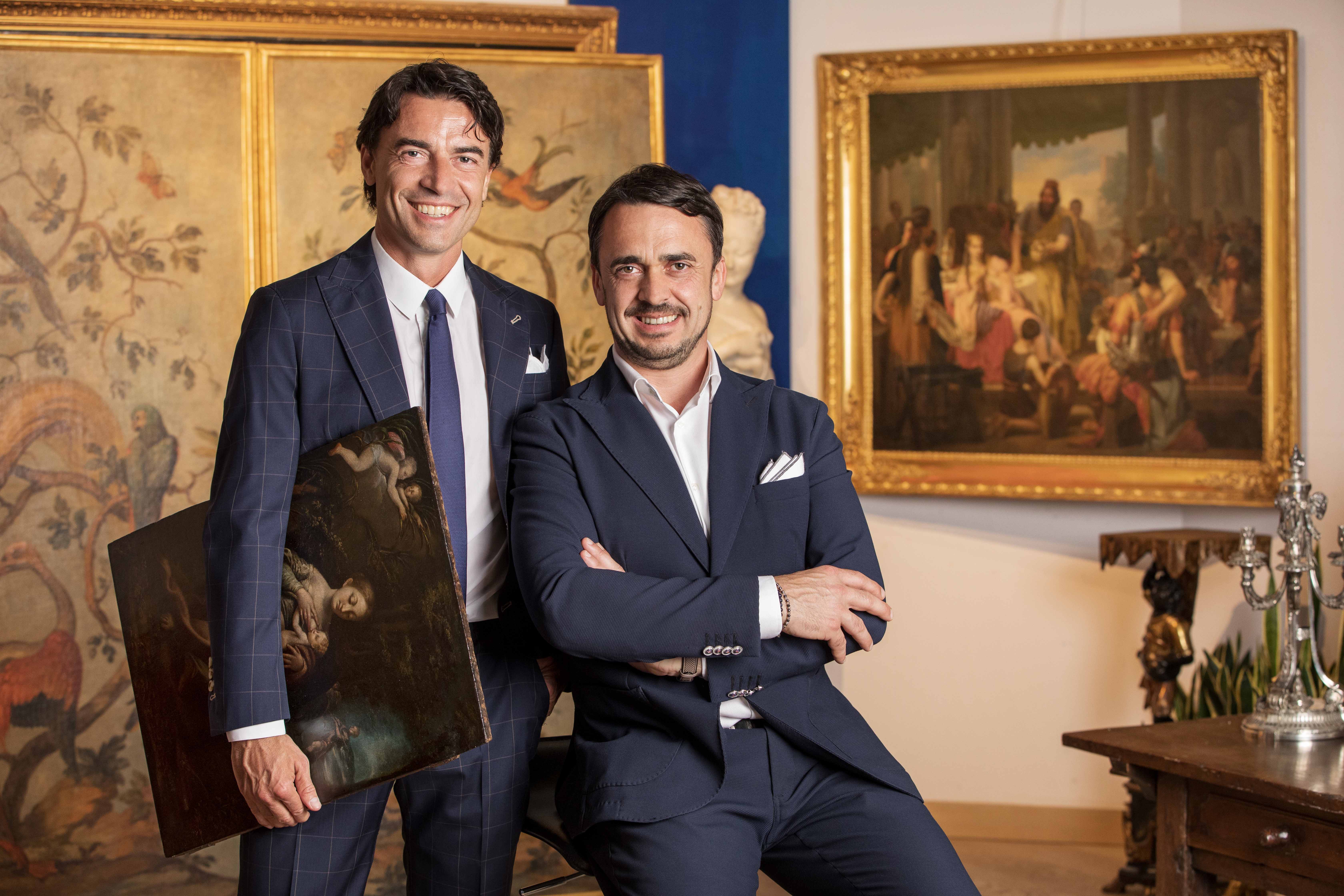
About the Seller
5.0
Vetted Professional Seller
Every seller passes strict standards for authenticity and reliability
Established in 2000
1stDibs seller since 2021
30 sales on 1stDibs
- ShippingRetrieving quote...Shipping from: Milan, Italy
- Return Policy
Authenticity Guarantee
In the unlikely event there’s an issue with an item’s authenticity, contact us within 1 year for a full refund. DetailsMoney-Back Guarantee
If your item is not as described, is damaged in transit, or does not arrive, contact us within 7 days for a full refund. Details24-Hour Cancellation
You have a 24-hour grace period in which to reconsider your purchase, with no questions asked.Vetted Professional Sellers
Our world-class sellers must adhere to strict standards for service and quality, maintaining the integrity of our listings.Price-Match Guarantee
If you find that a seller listed the same item for a lower price elsewhere, we’ll match it.Trusted Global Delivery
Our best-in-class carrier network provides specialized shipping options worldwide, including custom delivery.More From This Seller
View All17th Century Mystical Marriage of Saint Catherine Oli on Canvas Roman School
Located in Milan, IT
17th century, Roman School
Mystical marriage of Saint Catherine of Alexandria
Oil on canvas, 32 x 23 cm
Frame cm 45 x 36
The saint is depicted in front of the Virgin holding the Child portrayed with the wedding ring in his hand, enriched with a precious stone. According to the Golden Legend, Catherine of Alexandria was a very beautiful young woman, the only daughter of the king of Costa, who had refused to marry the emperor Maxentius because she was a Christian and devoted to Christ. Maxentius, unable to convince her to sacrifice to idols, had sent to call the wisest men and fifty philosophers and orators who presented themselves and tried to divert her from faith in Christ. Catherine, however, played so well that she was able to convert them, arousing the anger of the emperor who condemned them to the stake. Catherine, however, who had criticized Maxentius for the new persecutions against the Christians, was sentenced to prison without food. Abandoned for twelve days, she was fed by a dove sent by God. Maxentius then decided to execute her with the torture of the toothed wheel become her attribute iconographic; but by divine intervention this broke and the young was saved. Finally, she was beheaded and milk flowed from her neck. Catherine’s princely status is witnessed here by her sumptuous dress. The iconography of the mystical marriage was born in the fifteenth century, probably because the traditional iconographic attribute, the wheel, was sometimes so small as to look like a ring, and refers to a vision that will always remain present in the mind and heart of the saint. In Heaven she appeared to her, among the Angels and Saints, Christ the Child, in the arms of the Virgin. He took a precious ring that the Virgin Mary handed to her and put it in her finger, saying "I, your Creator and Saviour, take you in marriage; confident that you will keep you pure until you celebrate your eternal wedding with me, in Paradise" When Catherine was laughing, she found in her finger the same ring that she had seen and had in Heaven, and she considered herself forever the bride of Christ.
In this extraordinary episode we can see the heart of Catherine’s religious sense, and of all her spirituality. For her, Christ is like the bridegroom, with whom there is a relationship of intimacy, communion and fidelity; he is the beloved, whom she loves above all...
Category
Antique 17th Century Italian Decorative Art
Materials
Canvas
17th Century Rest on the flight to Egypt Emilian School Painting Oil on panel
By Parmigianino
Located in Milan, IT
17th century, Emilian school, Pamigianino painter
Rest on the flight to Egypt
Oil on panel, 46 x 39 cm - with frame 55.5 x 48.5 cm
The wor...
Category
Antique 17th Century Italian Paintings
Materials
Wood
17th Century Rest on The Flight to Egypt Emilian school Painting Oil on Canvas
Located in Milan, IT
17th century, Emilian school
Rest on the flight to Egypt
Oil on canvas, 42 x 33 cm
Frame 65 x 55 cm
The present Holy Family, ...
Category
Antique 17th Century Italian Paintings
Materials
Canvas
17th Century Madonna with Child Painting Oil on Canvas Tuscan School
Located in Milan, IT
17th century, Tuscan school
Madonna and Child
Oil on canvas, 31 x 21 cm
With frame, cm 37,5 x 27,5
The pearly incarnations and the thoughtful play of looks between the Virgin, turned to the Son, and Questi, warmly open to the viewer, pour out the present painting with compositional perfection. Virginal fabrics become mottled at the folds, wrapping the Madonna in a thin vitreous mantle. The pastel colors, shining on the pink robe just tightened at the waist by a gold cord, enliven the faces of the divine couple in correspondence of the cheeks, lit by an orange warmth. Even the left hand of the Virgin, composed in perfect classical pose (Botticelli, Madonna with Child, 1467, Musée du Petit Palais, Avignon), is sprinkled with warmth thanks to the immediate touch with Christ. From the nimbus of the Mother a delicate luminous disk is effused, which takes back, in the most distant rays, the colour of the hair of the Son, from the tones of the sun. The Child Jesus is represented intent in a tender gesture of invitation with the right hand, while with the other he offers a universal blessing: with his hand he retracts the index and annular palms, extending the remaining three fingers, symbol of Father, Son and Holy Spirit.
The painting welcomes and re-elaborates that typically Tuscan formalism that boasted in the rest of Italy the constant appreciation by the most up-to-date artists and collectors. Arrangement, composition and mixing of colors place the canvas in the middle between the changing mannerist and the sculptural figures of Michelangelo, essential yardstick of comparison in terms of anatomical and expressionistic rendering. In the present, silvery and pinkish powders act as three-dimensional inducers to the Child’s mentioned musculature and to the vivid folds of the clothes, expertly deposited on the lunar whiteness of the skins. While these colours recall the equally brilliantly transparent colours of Pier Francesco Foschi...
Category
Antique 17th Century Italian Paintings
Materials
Canvas
16th Century Adoration of The Shepherds Painting Oil on Copper
Located in Milan, IT
Attr. to Girolamo Siciolante known as da Sermoneta (Sermoneta, 1521 - Rome, 1575)
Adoration of the Shepherds
Oil on copper, 39 x 29.5 cm
Frame 47 x 39 cm
The refined taste, the refined poses, the definition of the anatomies, the vibrant light, allow us to identify for this painting the hand of a Mannerist painter active during the sixteenth century. In particular, the composition and stylistic research allow us to attribute the panel to Girolamo Siciolante, known as da Sermoneta (1521 - 1575). His first training took place under the guidance of Leonardo Grazia known as da Pistoia (1502 - 1548). Later he settled in Rome where he was able to see the painting of Raphael and Michelangelo from life and where he was first a pupil and then a collaborator of Perin del Vaga...
Category
Antique 16th Century Italian Paintings
Materials
Copper
17th Century Annunciation Painting Oil on Canvas Workshop of Nuvolone
Located in Milan, IT
17th century, Nuvolone workshop
Annunciation
Measures: Oil on canvas, 98.50 x 127.00 cm - with frame 144 x 115
Depicted is a canonical Annunciation which sees Mary on her knees ...
Category
Antique 17th Century Italian Paintings
Materials
Canvas
You May Also Like
Ancient painting "Madonna and Saint Anne" from the 17th century.
Located in Cesena, FC
Ancient painting "Madonna and Saint Anne" from the 17th century.
Lombard (Italy) painter.
Title: Madonna with Child and Saint Anne between Saint Joseph and Saint Paul
Oil on canvas...
Category
Antique Mid-17th Century Italian Paintings
Materials
Canvas, Paint
17th Century Oil on Canvas Italian Religious Painting Holy Family, 1660
Located in Vicoforte, Piedmont
Antique Italian painting from the 17th century. Oil on canvas artwork depicting a wonderful Holy Family. Painting of remarkable pictorial quality, particularly evident in the masterf...
Category
Antique 1660s Italian Paintings
Materials
Canvas
16th Century Oil on Canvas Tuscan School Antique Religious Painting Holy Family
Located in Vicoforte, Piedmont
Great Italian painting from the second half of the 16th century. Oil on canvas painting depicting a Holy Family from the Tuscan school of remarkable pictorial quality. We find the typical stylistic features of the Renaissance with a wonderful pyramidal composition, a refined chromatic palette and particular attention to the drapery. In the center is the Madonna with the baby Jesus in her arms who reaches out toward Saint John the Baptist with a lamb at his side, a symbol of Christ's sacrifice. At the top left we see Saint Joseph sleeping...
Category
Antique 16th Century Italian Paintings
Materials
Canvas
The Holy Family And St John The Baptist Religious Panel, 17th Century
Located in Lisbon, PT
This Flemish panel painting, dated circa 1620, masterfully depicts the Holy Family and young Saint John the Baptist.
A Flemish School altarpiece work of art, a masterfully achieved ...
Category
Antique 17th Century Italian Renaissance Paintings
Materials
Wood
$29,075 Sale Price
20% Off
"Mystic Marriage of Saint Catherine of Alexandria with Saint Jerome" Painting
Located in Cesena, FC
Author : Biagio D'Antonio
Mystic Marriage of Saint Catherine of Alexandria with Saint Jerome
Period : 15th century
Work by Biagio d'Anto...
Category
Antique 15th Century and Earlier Italian Paintings
Materials
Canvas
Italian 18th Century Oil on Canvas "Madonna and Child" after Giovanni Lanfranco
By Giovanni Lanfranco
Located in Los Angeles, CA
A very fine Italian 18th century oil on canvas "Madonna and Child" after Giovanni Lanfranco (Italian, 1582-1647). The young Virgin Mary attending to...
Category
Antique 18th Century Italian Baroque Paintings
Materials
Canvas, Giltwood
$19,850 Sale Price
39% Off
